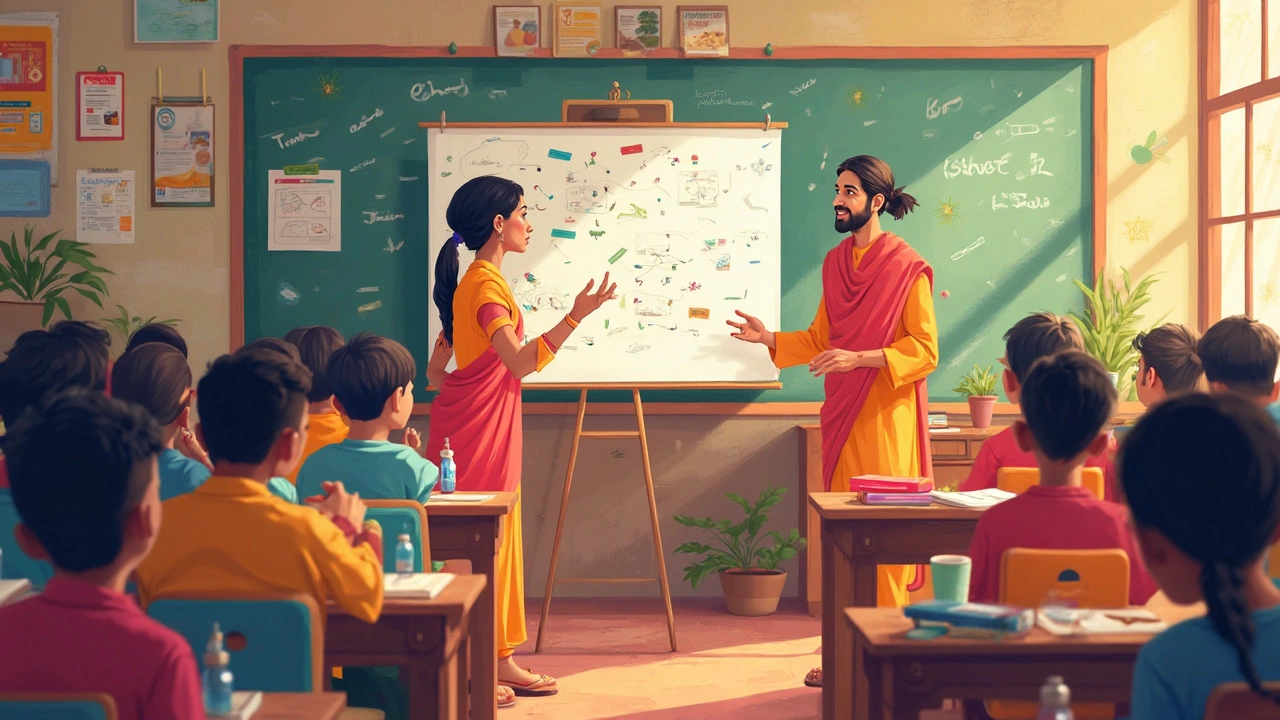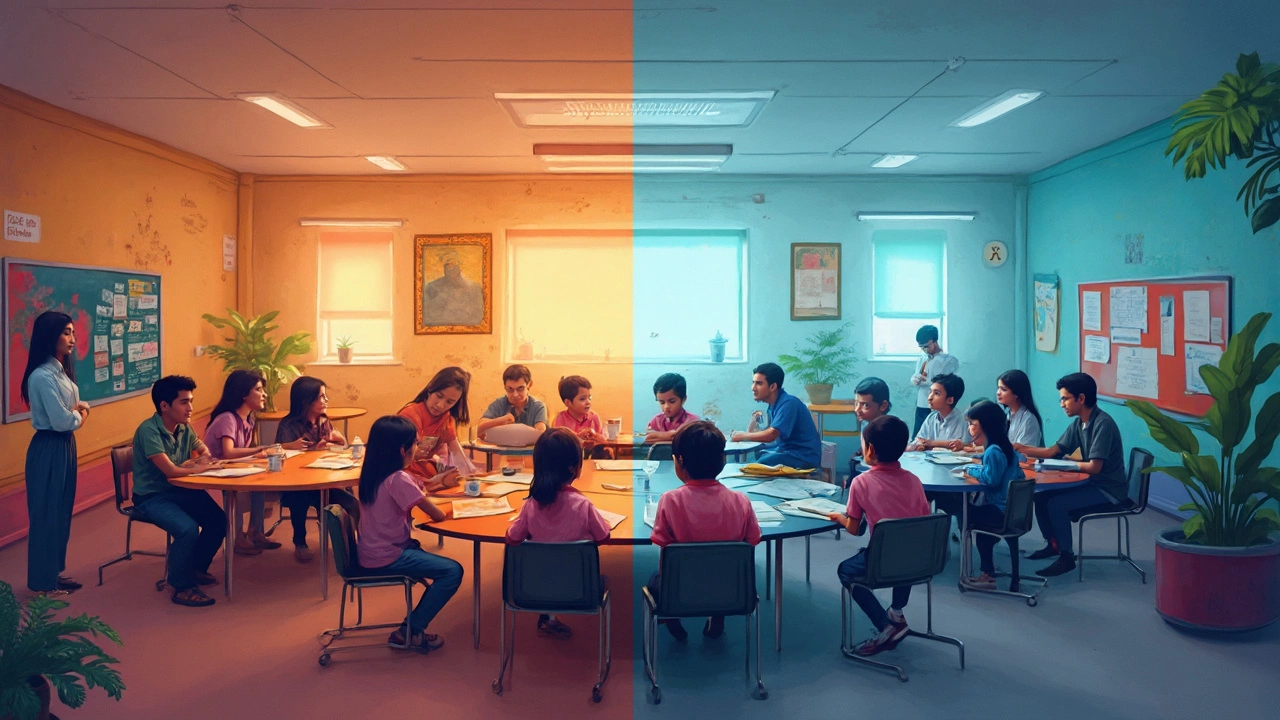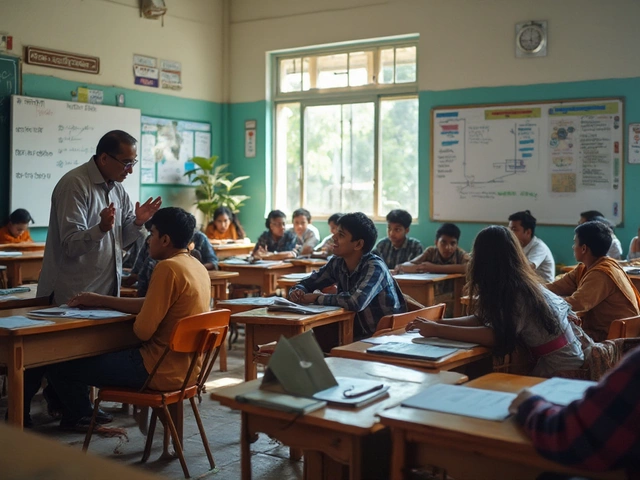
Choosing the best education system for a child is no easy task. It's like trying to pick the best dessert—everyone has their preferences! When it comes to comparing India and the USA, especially through the lens of the CBSE syllabus, it can feel like comparing apples to oranges. But don't worry—I'm here to break it down, so you don't have to stress.
The CBSE syllabus in India is known for its structured approach, with a strong focus on maths and science. But does this mean students are missing out on creativity? Meanwhile, in the USA, education takes a more flexible route, emphasizing critical thinking and creativity. Is that enough to build a strong foundation in core subjects?
- Overview of the CBSE Syllabus
- Teaching Methods: India vs USA
- Assessment and Evaluation Techniques
- Extra-curricular Opportunities
- Accessibility and Inclusivity
- Conclusion: Striking the Balance
Overview of the CBSE Syllabus
The CBSE syllabus is known for its structured and comprehensive approach, balancing both theory and practice. This Indian education board covers a range of subjects, with a clear focus on core subjects like maths and science, which often steal the spotlight.
What sets the CBSE apart? First off, it's nationally recognized and followed by most schools in India, meaning students can easily transfer between schools without disrupting their education. Plus, it's designed in a way that helps students prepare for competitive exams, like the IIT-JEE or NEET, right from an early stage.
Annual Curriculum Structure
CBSE runs an academic year stretching from April to March, typically divided into two terms. Each term concludes with assessments, keeping students engaged throughout the year.
- Core Subjects: The curriculum focuses heavily on subjects such as English, Hindi, Mathematics, Science (Physics, Chemistry, Biology), and Social Science.
- Elective Subjects: Students in higher classes can choose electives like Computer Science, Music, and Art, although these often take a backseat frequency-wise compared to core subjects.
Approach to Teaching and Learning
Learning in CBSE isn't just about cramming facts; it's about understanding concepts. Schools following this system aim to make students grasp the fundamentals, which can later help them in higher education.
| Subject | Focus Area |
|---|---|
| Math | Conceptual understanding, problem-solving skills |
| Science | Theoretical knowledge, laboratory experiments |
| Social Science | Historical events, civic knowledge |
Despite being structured, there's room for critical thinking and practical application through various projects and hands-on experiences. The argument here is that it creates a well-rounded, knowledgeable student prepared to tackle whatever higher education throws at them.
Teaching Methods: India vs USA
When it comes to education in India, the teaching methods are pretty unique compared to what you see in the USA. In India, the focus is heavily on theoretical knowledge delivered through the CBSE syllabus. Classrooms often feature traditional 'chalk and talk' styles where teachers lead lectures and students take notes. It's like a well-oiled machine designed to cover a lot of information in a short time.
On the flip side, USA schools follow a more student-centered approach. Teachers act more as guides rather than leaders. They encourage open discussions and critical thinking. Group work is also a staple here, promoting teamwork and interpersonal skills. This method aims to make students more proactive and involved in their learning process.
"In India, education is more about knowing facts, whereas in the USA, it's about knowing how to find and use those facts," says Dr. Shyam Sundar, an education expert.
Differences in Educational Tools
In Indian schools, especially within the CBSE framework, textbooks are the primary resources. Many students in India also rely heavily on supplementary study materials and private tuitions to excel. This supplementary teaching helps cover areas that might not get much attention in class.
In contrast, American schools offer a plethora of resources, from digital platforms to libraries stocked with diverse materials. Students have access to online forums, e-learning tools, and even VR technologies aimed at learning. This diverse toolkit is meant to cater to various learning styles and needs.
Parental Involvement and Extra Attention
In India, parental involvement is quite hands-on. Parents often take an active role in managing their child's education, whether through supervising homework or arranging extra tutoring. Education is seen as a family priority.
Meanwhile, in the USA, education systems emphasize independent learning. Parents are encouraged to support but not to intervene too much. This approach aims to build autonomy in students, fostering their individual development throughout their schooling.
Both systems have their strengths and weaknesses, and understanding these can help educators and parents create the best possible learning environment for students.
Assessment and Evaluation Techniques
When it comes to figuring out what's working and what's not in education, assessment and evaluation are the superheroes of the academic world. But if we're comparing India and the USA, the strategies can be pretty different.
In India, especially under the CBSE syllabus, exams and tests are a big deal. Students spend a lot of time prepping for board exams, which focus mainly on rote learning and memorization. It's all about scoring high to get into a good college. There's a lot of pressure, no doubt about that. It's kinda like a marathon where you have to run at a consistent pace, gathering facts and storing them for the big day.
Frequent Testing in the USA
On the flip side, in the USA, continuous and formative assessments are more common. Instead of one massive exam, there's a focus on quizzes, projects, and presentations throughout the year. This helps teachers catch problems early and adjust teaching methods. It's more laid-back but still effective in understanding where a student stands conceptually. The aim here is more about understanding and applying knowledge rather than just recalling facts.
Plus, American schools often use standardized tests like the SAT or ACT for college admissions. They test reasoning abilities and are less about the grind of memorizing textbooks.
Impact on Students
With India's heavily examination-oriented system, students often experience high levels of stress. It's like being in a pressure cooker! On the other hand, the US system encourages participation and creativity, which can result in a more holistic development, but may not deep dive into every subject as thoroughly as the CBSE structure.
Interesting Stats
| Country | Average Student Stress Levels |
|---|---|
| India | 60% |
| USA | 40% |
Each system has its strengths, and sometimes it's about finding the right balance between these methods to cater to different learning needs and eventually, life skills. Ultimately, it's like comparing a sprinter to a marathon runner; both are effective, but in different ways and for different goals.

Extra-curricular Opportunities
Extra-curricular activities are a big deal for both Indian and American education systems, but they approach them somewhat differently. In India, especially under the CBSE syllabus, schools often emphasize academic achievement. However, there's been a push in recent years to include more holistic development through activities like sports, arts, and music.
CBSE schools are now regularly including programs like house competitions, annual day events, and inter-school sports meets. These activities do more than pad out a student's report; they help in building teamwork, leadership, and other important life skills.
On the flip side, American schools generally encourage extra-curricular involvement from an early age. It's common for students to engage in diverse interests ranging from drama clubs and robotics teams to community service projects. Some schools integrate these activities into the school's curriculum itself, allowing them to earn credit, which can be a dream for students who love getting involved!
Here's an interesting stat to chew on: A study found that about 70% of American high school students participate in some kind of extra-curricular activity. Unfortunately, I couldn't find a comparable stat for CBSE students, but field reports suggest that participation is growing among Indian students.
In both countries, extra-curriculars certainly help when applying to higher education institutions. In the USA, colleges often look for well-rounded applicants who have not only excelled academically but have also participated in various activities. Meanwhile, in India, extracurricular achievements can give students an edge during admissions through the sports or cultural quotas.
Accessibility and Inclusivity
When it comes to accessibility and inclusivity in education, both India and the USA have their set of challenges and victories. Let’s dive into how these countries stack up, especially in the context of the CBSE syllabus and general educational practices.
India: The CBSE Approach
In India, accessibility is steadily improving, but there's still work to do. The CBSE board has been making efforts to include more inclusive policies. Schools are now mandated to have ramps and special educators to cater to students with learning disabilities. However, rural areas often see a lack of resources, which can create a gap between urban and rural education quality.
Moreover, the digital divide is a massive hurdle. While urban schools may have smart classrooms, many rural schools struggle with basic internet access, affecting students' opportunities to learn and grow equally.
USA: Tailored Education
The USA is known for its inclusive education system, with federal laws like the Individuals with Disabilities Education Act (IDEA) ensuring students with disabilities receive appropriate services. It emphasizes personalized learning plans so that every student, regardless of their background, can thrive. However, public schools here can vary significantly in quality, which means not all students get the same level of education.
The focus in US schools on inclusivity isn’t just about physical accessibility; it's also about cultural sensitivity. Schools often have counselors to address issues of diversity, ethnicity, and language barriers, though implementing these effectively across all states is still a work in progress.
| Country | Urban Accessibility | Rural Accessibility |
|---|---|---|
| India | Better facilities, more tech access | Lacking basic resources |
| USA | High standard facilities | Varies, but generally better resources |
Improving accessibility and inclusivity is essential in both countries. The education USA model, with its personalized approach, sets an inclusive benchmark, while India, through its focus on uniform exams like the CBSE, reaches wide but must address deeper inclusivity issues. Both nations have their strengths and avenues for improvement that can inspire future educational policies worldwide.
Conclusion: Striking the Balance
So, where does this leave us? Is the education system in India better with its focus on the CBSE syllabus, or does the USA offer a superior approach with its emphasis on creativity and individuality? Well, it really depends on what you value more as a parent or an educator.
India's CBSE curriculum provides a strong foundation in theoretical knowledge. Students often excel in technical fields like engineering and medicine because they've spent years mastering subjects through structured methodologies. However, this comes with the pressure of intense memorization and less room for individual expression.
On the flip side, the USA educational system, while perhaps not as rigidly structured, encourages analytical skills and out-of-the-box thinking from a young age. Students may engage more with arts, humanities, and extra-curricular activities, which can foster overall development. But some argue that it might lack the depth in scientific and mathematical training that systems like CBSE provide.
Accessibility in both countries has its own set of challenges. While urban areas in India tend to have excellent access to CBSE education, rural regions may not. On the other hand, the vast network in the USA brings different challenges like educational inequality based on socioeconomic status.
Parents and students aiming to strike a balance could benefit from picking elements from both systems. For instance, maintaining core scientific disciplines from India's curriculum while fostering creative skills from the American system could provide a well-rounded education.
This requires educators and policymakers to step out of traditional molds and innovate. By blending India's analytical rigor with America's creative flexibility, we might create an educational environment that caters to holistic growth. It’s less about choosing sides and more about cherry-picking the best bits from each to craft an approach that equips young minds for a globally competitive world.
More Articles

Which Degree Is the Easiest? A Practical Guide to Low‑Effort Online Degrees
Discover which online bachelor's degrees are the least demanding, their pros and cons, and a step‑by‑step guide to pick the right easy degree for your career.

Understanding the Math Involved in MBA Programs
The question of whether an MBA is math heavy often arises among prospective students. While math is an integral part of any MBA curriculum, the level and type can vary greatly between programs. Quantitative skills are essential for areas such as finance and operations, but they are not the only focus of an MBA. Many programs offer foundational courses to help students develop these skills without requiring an extensive math background.

Top Institutes for Successful Government Job Preparation
Preparing for government jobs is a significant undertaking that can greatly benefit from the guidance of specialized institutes. This article explores some of the best institutes for government job preparation, examining their strengths, teaching methodologies, and resources. It offers valuable tips and insights for aspirants looking to choose the right place for their studies. The piece also highlights interesting facts about these institutes to help inform prospective students.
